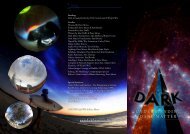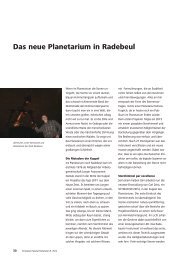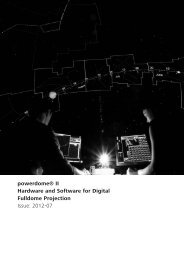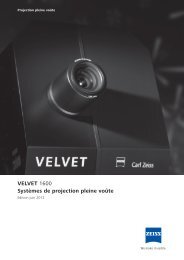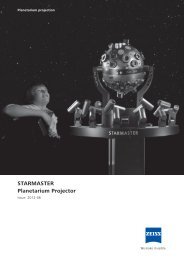Innovation Special Planetariums 9 - Carl Zeiss Planetariums
Innovation Special Planetariums 9 - Carl Zeiss Planetariums
Innovation Special Planetariums 9 - Carl Zeiss Planetariums
Create successful ePaper yourself
Turn your PDF publications into a flip-book with our unique Google optimized e-Paper software.
We think it is important for our visitors<br />
not only to enjoy planetarium show but<br />
also to look up at the real sky and find<br />
the stars or constellations.<br />
Inspiring visitors to look up at the real<br />
sky, we needed to show stars as close to<br />
natural starry sky as possible and provide<br />
an interesting scientific theme with a<br />
live commentary, not recording for every<br />
single show (not very common in Japan).<br />
Two projection systems<br />
To project the beautiful starry sky and<br />
the realistic pictures on a big dome, a<br />
projector needs high quality. But it is<br />
26 <strong>Innovation</strong> <strong>Special</strong> <strong>Planetariums</strong> 9, 2012<br />
impossible to judge from catalog specification.<br />
So we finally decided which<br />
model of projectors we would use after<br />
repeating trial and error.<br />
We have both opto-mechanical and<br />
digital planetarium in the dome. The<br />
starball, UNIVERSARIUM Model IX from<br />
<strong>Carl</strong> <strong>Zeiss</strong> is installed exactly in the<br />
center of the dome. The new projector<br />
equipped with fiber optics that makes it<br />
possible to show the beautiful stars with<br />
high brightness levels and small size. We<br />
were able to negotiate <strong>Zeiss</strong> engineers<br />
to adjust the brightness and color tone<br />
of stars. They were so cooperative that<br />
we were able to order digital controlled<br />
shutters for the stars and Milky Way,<br />
special constellation outlines and Japanese<br />
characters. We visited their factory<br />
in Jena three times and discussed trial<br />
products such as interfaces for manual<br />
operation again and again to work<br />
closely.<br />
The number of visible stars (6.5th magnitude)<br />
to human eye is about 9,100.<br />
It depends to sensitivity of the human<br />
eye. There are some starballs projecting<br />
more than millions of stars now but we<br />
are not willing to project invisible stars.<br />
About 9,100 are as many stars as we




